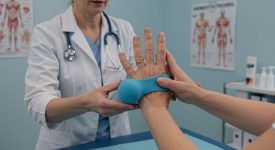
Hand Therapy and Exercises for Dupuytren’s Disease: What Works?
7 Proven Recovery Exercises and Hand therapy for Dupuytren’s Disease That Really Work
Introduction for Hand therapy and exercises
Hand therapy is a cornerstone of Dupuytren’s management. While it cannot cure the disease, it preserves mobility, reduces stiffness, and restores function after needle release, enzyme injection, or surgery.
Role of Therapy
Therapists focus on stretching contracted fascia, maintaining joint range of motion, and enhancing circulation. Early movement prevents tissue shortening and joint adhesions (American Society for Surgery of the Hand).
Before Treatment
Gentle flat-hand presses, finger spreads, and palm massage help retain flexibility. Avoid painful or forceful stretching that may tear cords.
After Treatment
Following needle aponeurotomy or collagenase injection, therapy reduces swelling and guides safe motion. After surgery, scar mobilization and progressive strengthening prevent recurrence.
👉 Internal link: Collagenase Injections for Dupuytren’s
Treatment typically starts within days and continues for several weeks to months.
Common Techniques
- Splinting: Night extension splints maintain finger position.
- Massage & Scar Work: Keeps new collagen aligned.
- Range-of-Motion Drills: Gentle flexion and extension.
- Functional Training: Grip practice and fine motor tasks.
The Science Behind Movement
Controlled motion stimulates fibroblast remodeling and nutrient delivery. NIH rehabilitation data show that measured stretch improves collagen alignment. Heat before exercise and ice after reduce swelling.
👉 Internal link: Splinting in Dupuytren’s Disease
Patient Commitment
Therapy works only with daily practice. Skipping sessions can lead to stiffness returning within months. Consistency turns short-term gains into lasting function.
What the Research Shows
J Hand Ther. (2015) found patients who followed structured programs regained motion 30–40 % faster and had half the recurrence rate of non-participants.
Connections to Dupuytren’s
Therapy bridges medical treatment and daily life—keeping hands functional and confidence high. It is the anchor that preserves surgical results.
1. Gentle Stretch Routine
Daily extension movements keep the fingers straight and mobile. Lay your hand flat on a table, press gently from the palm outward, and hold for 10 seconds. This controlled motion encourages collagen fibers to align correctly and improves circulation in the healing fascia.
2. Finger Spreads
Place a rubber band around your fingers and slowly stretch them apart. Repeat 10–15 times. This low-resistance movement strengthens the small muscles between the fingers and maintains a full range of motion.
3. Soft Ball Grip Training
Squeeze a soft foam or therapy ball for 5 seconds, then release. Perform 15 repetitions. Grip strengthening restores everyday function, like holding utensils or typing, while keeping tension balanced across the palm.
4. Scar Mobilization Massage
Once your incision or injection site has healed, gently massage the scar in circular motions with vitamin-E or silicone gel. This prevents tissue sticking and promotes smooth collagen remodeling. Use light pressure—pain means you’re pressing too hard.
5. Heat Before, Ice After
Warming the hand before stretching softens tissues and boosts blood flow. Applying a cool compress after exercise reduces inflammation and swelling. This hot-cold contrast helps manage discomfort during recovery.
6. Night Splinting for Extension
Wearing a custom night splint keeps fingers in a neutral or slightly extended position. It helps maintain gains from daily practice and prevents contractures from redeveloping during rest.
7. Functional Reintegration
Incorporate practical tasks—buttoning a shirt, writing, or gripping objects—into therapy sessions. Functional training builds confidence and ensures strength translates into real-life use.
Consistency Is Key
These exercises only work when practiced regularly. Skipping sessions can cause stiffness to return within weeks. A few minutes each day can make the difference between lasting recovery and relapse.
When to Reassess
If you notice reduced movement or new nodules forming, consult your specialist early. Timely adjustment of the exercise plan can slow progression and preserve mobility.
Final Thoughts
Therapeutic movement bridges medical treatment and daily life. With commitment, the right exercises, and guidance from professionals, most patients regain flexibility and reduce recurrence risk—proving that disciplined self-care truly works.
If you’re living with diabetes, learn how to protect your hands. Visit https://www.dupuytrensolutions.com and join our support network at https://www.facebook.com/groups/dupuytrensolutionsandhealth.


